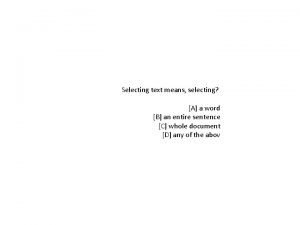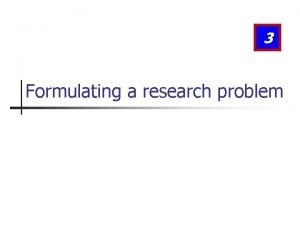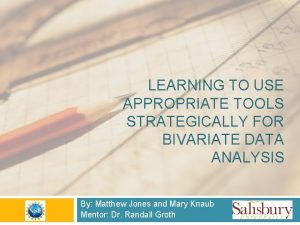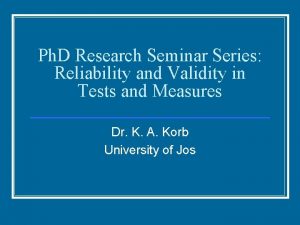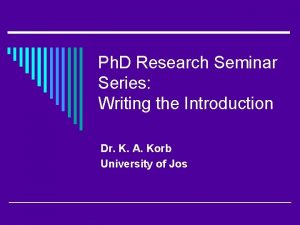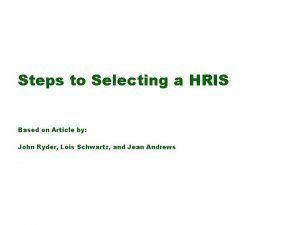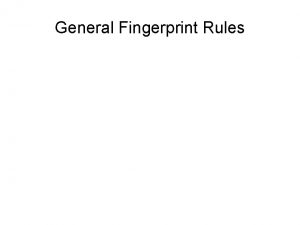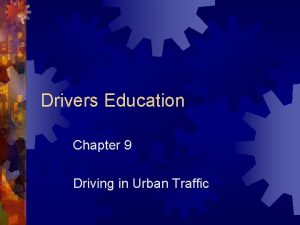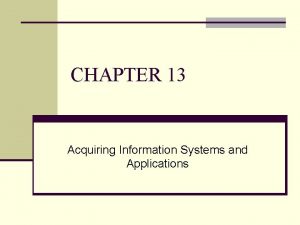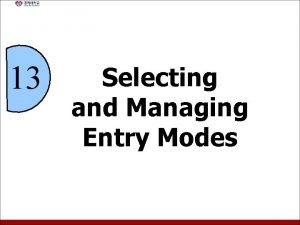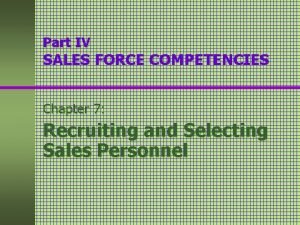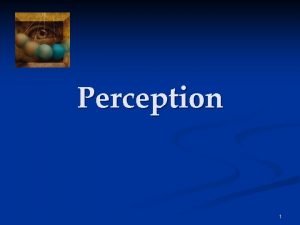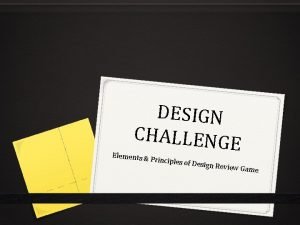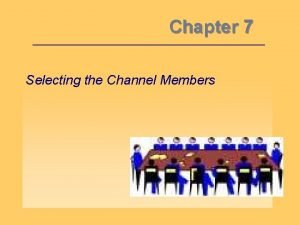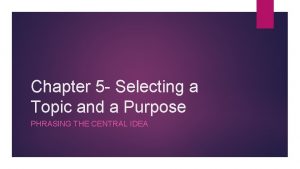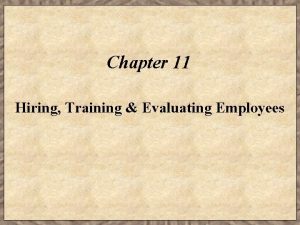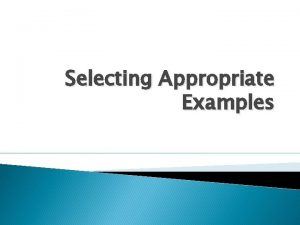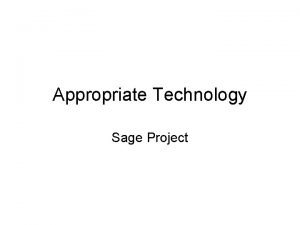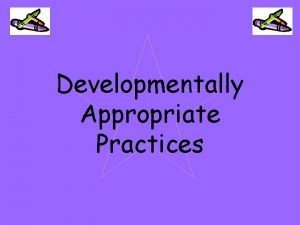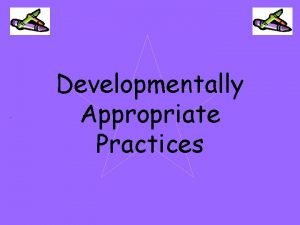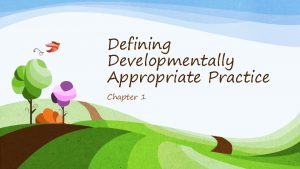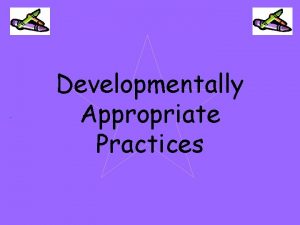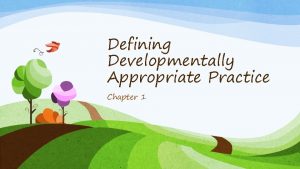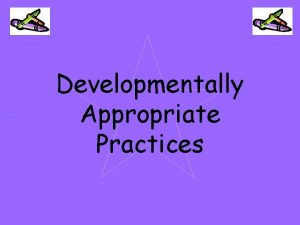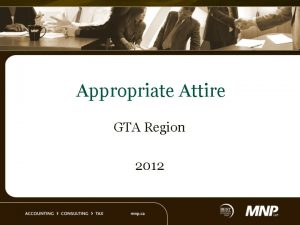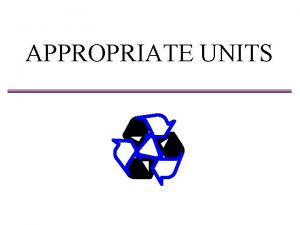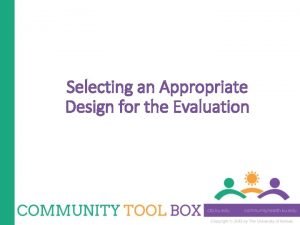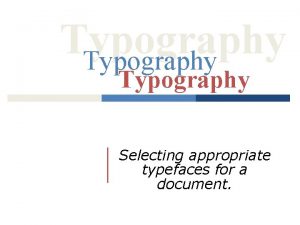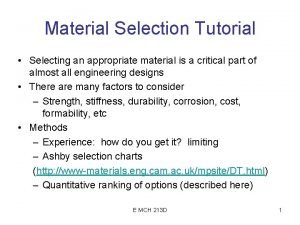Research Seminar Tools of Research v Selecting appropriate























- Slides: 23

Research Seminar

Tools of Research v Selecting appropriate and useful measuring instruments is critical to the success of any research study. One must select or develop scales and instruments that can measure complex constructs such as intelligence, achievement, personality, motivation, attitudes, aptitudes, interests, and self-concept. v There are two basic ways to obtain these measures for your study: Use one that has already been developed or construct your own.

Notes v To select a measuring instrument, the researcher should look at the research that has been published on his or her question to determine what other researchers have used to measure the construct of interest. v If researchers cannot find a previously developed instrument, then they must develop their own.

The main types of measuring instruments that are used in educational research: Attitude Scales Personality Tests Achievement & Aptitude Tests Observational Techniques

TESTS v Tests are valuable measuring instruments for educational research. v A test is a set of stimuli presented to an individual in order to elicit responses on the basis of which a numerical score can be assigned. This score, based on a representative sample of the individual’s behavior, is an indicator of the extent to which the subject has the characteristic being measured.

v The utility of these scores as indicators of the construct of interest is in large part a function of the objectivity, validity, and reliability of the tests. Objectivity is the extent of agreement among scorers. Some tests, such as multiplechoice and true–false tests, are described as objective because the scoring is done by comparing students’ answers with the scoring key, and scorers need make no decisions. Essay tests are less objective because scores are influenced by the judgment and opinions of the scorers.

v In general, validity is the extent to which a test measures what it claims to measure. v. Reliability is the extent to which the test measures accurately and consistently

ACHIEVEMENT TESTS v Achievement tests are widely used in educational research, as well as in school systems. They are used to measure what individuals have learned. v Achievement tests measure mastery and proficiency in different areas of knowledge by presenting subjects with a standard set of questions involving completion of cognitive tasks. Achievement tests are generally classified as either standardized or teacher/researcher made.

Standardized Tests v Standardized tests are published tests that have resulted from careful and skillful preparation by experts and cover broad academic objectives common to the majority of school systems. These are tests for which comparative norms have been derived, their validity and reliability established, and directions for administering and scoring prescribed.

v. Standardized achievement tests are available for single school subjects, such as mathematics and chemistry, and also in the form of comprehensive batteries measuring several areas of achievement.

v In selecting an achievement test, researchers must be careful to choose one that is reliable and is appropriate (valid) for measuring the aspect of achievement in which they are interested. v There should be a direct link between the test content and the curriculum to which students have been exposed. v The test must also be valid and reliable for the type of subjects included in the study. Sometimes a researcher is not able to select the test but must use what the school system has already selected.

Researcher-Made Tests v The advantage of a researcher-made test is that it can be tailored to be content specific; that is, it will match more closely the content that was covered in the classroom or in the research study. v For example, suppose a teacher wants to compare the effects of two teaching methods on students’ achievement in mathematics.

Norm-Referenced and Criterion. Referenced Tests v On the basis of the type of interpretation made, standardized and teacher-made tests may be further classified as norm-referenced or criterion-referenced. v Norm-referenced tests permit researchers to compare individuals’ performance on the test to the performance of other individuals. An individual’s performance is interpreted in terms of his or her relative position in a specified reference group known as the normative group. Typically, standardized tests are norm referenced, reporting performance in terms of percentiles, standard scores, and similar measures.

v In contrast, criterion-referenced tests enable researchers to describe what a specific individual can do, without reference to the performance of others. v Performance is reported in terms of the level of mastery of some well-defined content or skill domain.

Test Performance Range v The range of performance that an achievement test permits is important. Researchers want a test designed so that the subjects can perform fully to their ability level without being restricted by the test. v Two types of testing effects may occur. A ceiling effect occurs when many of the scores on a measure at or near the maximum possible score. Tests with a ceiling effect are too easy for many of the examinees, and we do not know what their scores might have been if there had been a higher ceiling.

Performance Assessments v A performance test is a technique in which a researcher directly observes and assesses an individual’s performance of a certain task and/or judges the finished product of that performance. The test taker is asked to carry out a process such as playing a musical instrument or tuning a car engine or to produce a product such as a written essay. The performance or product is judged against established criteria.

Constructing a Performance Test To create a performance test, follow these three basic steps: 1. Begin with a clear statement of the objectives and what individuals will be asked to do and the conditions under which the task will be performed. A set of test specifications listing the critical dimensions to be assessed will lead to a more comprehensive coverage of the domain. State whethere will be time limits, whether reference books will be available, and so on.

2 -Provide a problem or an exercise that gives students an opportunity to perform—either a simulation or an actual task. All individuals must be asked to perform the same task. 3. Develop an instrument (checklist, rating scale, or something similar) that lists the relevant criteria to use in evaluating the performance and/or the product. Make sure that the same criteria are used for each individual’s performance or product

Notes v. Performance tests are useful for measuring abilities and skills that cannot be measured by paper-andpencil tests. However, they are time intensive and thus more expensive to administer and score.

APTITUDE TESTS v. Aptitude tests differ from achievement tests in that aptitude tests attempt to measure general ability or potential for learning a body of knowledge and skills, whereas achievement tests attempt to measure the actual extent of acquired knowledge and skills in specific areas.

v Aptitude tests measure a subject’s ability to perceive relationships, solve problems, and apply knowledge in a variety of contexts. Some critics question the distinction made between aptitude and achievement tests. v They point out that an aptitude test measures achievement to some extent, and an achievement test has an aptitude element. Aptitude tests were formerly referred to as intelligence tests.

Notes v. Aptitude or intelligence is frequently a variable that needs to be controlled in educational experiments. To control this variable, the researcher may use the scores from a scholastic aptitude test. v. Of the many tests available, some have been designed for use with individuals and others for use with groups.

 Selecting text means selecting
Selecting text means selecting Research problem formulation
Research problem formulation Use appropriate tools strategically
Use appropriate tools strategically Validity in psychology
Validity in psychology Research seminar definition
Research seminar definition Hris demonstration
Hris demonstration Investment risk example
Investment risk example Denture teeth size chart
Denture teeth size chart Characteristics of a relational database
Characteristics of a relational database Screening and selecting employees international
Screening and selecting employees international Rules of delta
Rules of delta 2. how can you best use the ipde process in city driving?
2. how can you best use the ipde process in city driving? Project identification and selection process
Project identification and selection process Selecting investment in global market
Selecting investment in global market Selecting and storing eggs
Selecting and storing eggs Methods of acquiring information system
Methods of acquiring information system Potential market
Potential market Recruiting and selecting sales personnel
Recruiting and selecting sales personnel Protectability brand elements examples
Protectability brand elements examples Selecting organizing and interpreting information
Selecting organizing and interpreting information Monochromatic refers to a painting done in one color.
Monochromatic refers to a painting done in one color. Chapter 7 selecting the channel members
Chapter 7 selecting the channel members What three brainstorming methods can you follow
What three brainstorming methods can you follow The process of selecting training and evaluating employees
The process of selecting training and evaluating employees
